Saturday, October 16, 2021
McBee
McBee cards were an obscure but surprisingly long-lived alternative to IBM's fully mechanized sorters and organizers. Especially in biology and chemistry, they were still around in the 1990s.
Hollerith cards were punched by machine and sorted by machine all the way from the start in 1880.
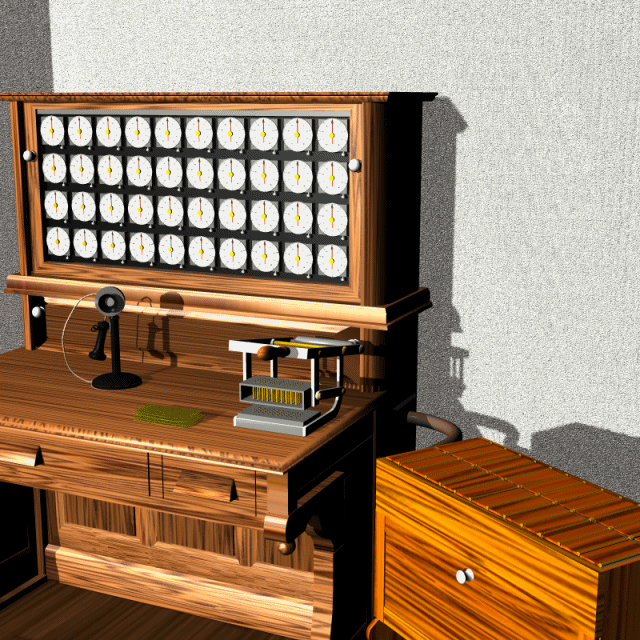 McBee cards could be punched and sorted by machine. The punching side was partly mechanized, but the sorting side was usually done by hand.
This has advantages and disadvantages. The most obvious advantage is cost. For McBee you need to order some cards, and you need a ticket-punch and an icepick and some boxes. The cards are the only real cost. For IBM you need to order some cards, and you also need to rent a keypunch and a sorter for about $150 a month (equals $1000 a month today). Individuals and small businesses could afford McBee.
When modeling and animating these processes I'm on halfway familiar ground. In the '50s I often helped my father with mechanical grading and categorizing for his college lecture classes. It was a job I truly enjoyed. I did a lot of sorting, and a little bit of hand-punching, but never encountered the punching machine illustrated below.
A typical McBee card had punchable fields all around the edge, and a writable area in the middle. The open central area was another advantage over Hollerith, which was solidly filled with punchable numbers. You could type or handwrite a considerable amount of info or diagrams in the center.
McBee cards could be punched and sorted by machine. The punching side was partly mechanized, but the sorting side was usually done by hand.
This has advantages and disadvantages. The most obvious advantage is cost. For McBee you need to order some cards, and you need a ticket-punch and an icepick and some boxes. The cards are the only real cost. For IBM you need to order some cards, and you also need to rent a keypunch and a sorter for about $150 a month (equals $1000 a month today). Individuals and small businesses could afford McBee.
When modeling and animating these processes I'm on halfway familiar ground. In the '50s I often helped my father with mechanical grading and categorizing for his college lecture classes. It was a job I truly enjoyed. I did a lot of sorting, and a little bit of hand-punching, but never encountered the punching machine illustrated below.
A typical McBee card had punchable fields all around the edge, and a writable area in the middle. The open central area was another advantage over Hollerith, which was solidly filled with punchable numbers. You could type or handwrite a considerable amount of info or diagrams in the center.
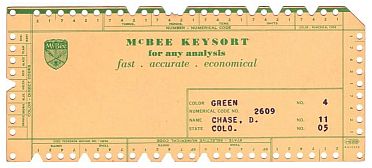 Cards were printed in a wide variety of individual styles for each business or purpose. Some had specialized non-numerical categories, some were all numerical, some were mixed alphanumeric.
McBee cards had a unique arithmetic system, based on 1 2 4 7. The system isn't a proper base-15, though it ranges from 0 to 14. The choice of these four digits was supposedly a compromise to minimize the number of punches needed. You could form all the digits from 0 to 9 with one or two punches. This was slightly more efficient than 4-bit binary.
Cards were printed in a wide variety of individual styles for each business or purpose. Some had specialized non-numerical categories, some were all numerical, some were mixed alphanumeric.
McBee cards had a unique arithmetic system, based on 1 2 4 7. The system isn't a proper base-15, though it ranges from 0 to 14. The choice of these four digits was supposedly a compromise to minimize the number of punches needed. You could form all the digits from 0 to 9 with one or two punches. This was slightly more efficient than 4-bit binary.
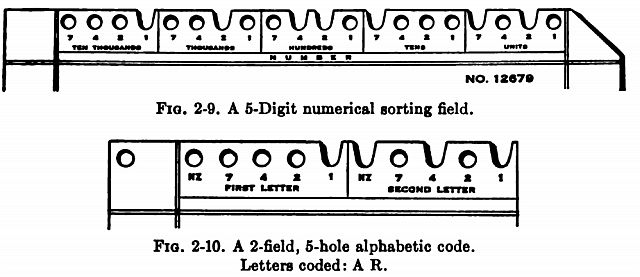 Letters were formed with 1 2 4 7 plus an extra, called NZ for nonzero. This was NOT more efficient than a 5-bit binary system, but the familiarity probably made it faster. Binary digits were totally foreign to most people until the 1980s, and it's always better to amortize an existing skill.
[Here's a comparison of efficiency in terms of total punches needed.]
One definite advantage of hand-sorted cards is flexibility of form. When the stack is going to be handled carefully and personally, you can include samples of material or photo images on or in each card. McBee cards with inset X-ray images were useful in medical records:
Letters were formed with 1 2 4 7 plus an extra, called NZ for nonzero. This was NOT more efficient than a 5-bit binary system, but the familiarity probably made it faster. Binary digits were totally foreign to most people until the 1980s, and it's always better to amortize an existing skill.
[Here's a comparison of efficiency in terms of total punches needed.]
One definite advantage of hand-sorted cards is flexibility of form. When the stack is going to be handled carefully and personally, you can include samples of material or photo images on or in each card. McBee cards with inset X-ray images were useful in medical records:
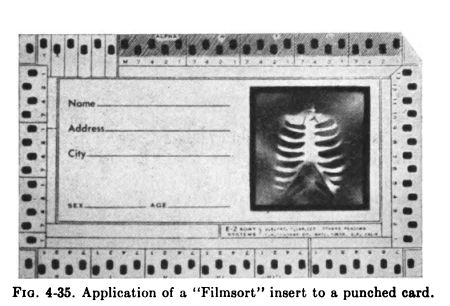 These inclusions couldn't pass through an IBM sorter or card-reader.
Hand punching was done with a special triangular hand punch that looked a lot like a ticket punch. My father didn't have the special, so we just used a ticket punch.
= = = = =
This punching machine was shown in one detailed description of McBee systems. No other information is available, so I'm semi-guessing the way it worked. I'm assuming that you would set up the patterns using the 8 columns of buttons for up to 8 numerical fields on one side of the card, then hit the big button on the right to punch these. The long side of a typical card contained 6 or 7 fields, so the 8 columns would usually handle one side of a card. I don't know what the 8 buttons on top were supposed to do. Maybe reset for each column? The process would have been like an adding machine except that you were consciously forming the 1247 pattern for each field.
These inclusions couldn't pass through an IBM sorter or card-reader.
Hand punching was done with a special triangular hand punch that looked a lot like a ticket punch. My father didn't have the special, so we just used a ticket punch.
= = = = =
This punching machine was shown in one detailed description of McBee systems. No other information is available, so I'm semi-guessing the way it worked. I'm assuming that you would set up the patterns using the 8 columns of buttons for up to 8 numerical fields on one side of the card, then hit the big button on the right to punch these. The long side of a typical card contained 6 or 7 fields, so the 8 columns would usually handle one side of a card. I don't know what the 8 buttons on top were supposed to do. Maybe reset for each column? The process would have been like an adding machine except that you were consciously forming the 1247 pattern for each field.
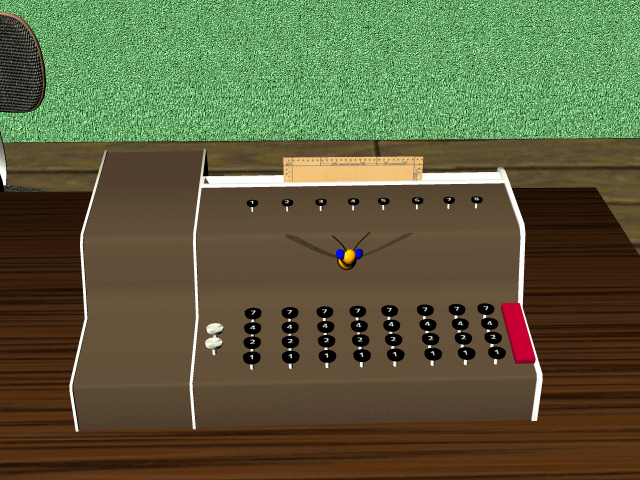 Mr McBee has just punched in 1309, so the card would look like this after turning it over:
Mr McBee has just punched in 1309, so the card would look like this after turning it over:
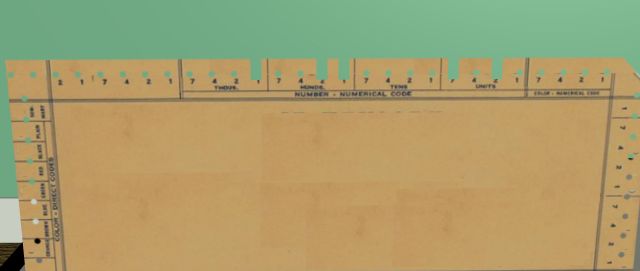 Now Polistra will demonstrate the first step of the selecting process. Assume she's looking for cards with 1309. She begins by finding cards with a 1 in the thousands place.
McBee selection is inverse to the usual way of thinking. It's more like the military volunteer method, where the soldiers who are NOT volunteering to check out the minefield are asked to step back, leaving the volunteers and the sleepers in the original row.
The poker was called a tumbler for some unknown reason. (It should have been a stinger.) Polistra inserts the tumbler into the 1 hole of the thousands field. Cards that were NOT punched in this slot can be pulled up, while the cards with a PUNCH in this digit stay down. She then places the UNWANTED cards in the red box, leaving only the few WANTED cards in the original blue box.
Now Polistra will demonstrate the first step of the selecting process. Assume she's looking for cards with 1309. She begins by finding cards with a 1 in the thousands place.
McBee selection is inverse to the usual way of thinking. It's more like the military volunteer method, where the soldiers who are NOT volunteering to check out the minefield are asked to step back, leaving the volunteers and the sleepers in the original row.
The poker was called a tumbler for some unknown reason. (It should have been a stinger.) Polistra inserts the tumbler into the 1 hole of the thousands field. Cards that were NOT punched in this slot can be pulled up, while the cards with a PUNCH in this digit stay down. She then places the UNWANTED cards in the red box, leaving only the few WANTED cards in the original blue box.
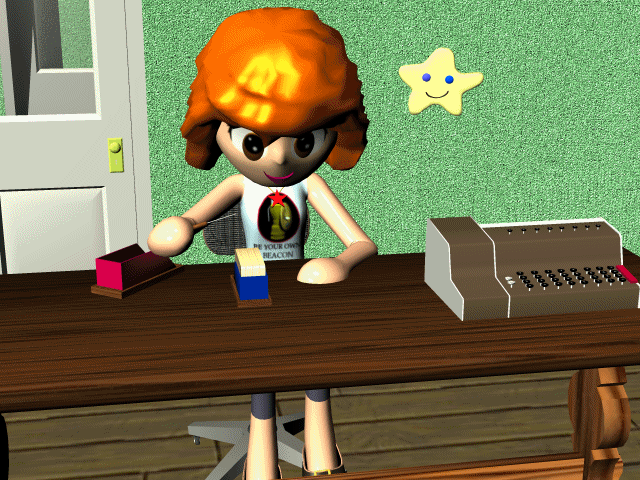 She would then tumble a 1 and a 2 in the hundreds field, to complete the 3; then do nothing for the zero in the tens field; then tumble the 2 and 7 in the ones field.
All remaining cards in the original blue box would then be 1309.
She would then tumble a 1 and a 2 in the hundreds field, to complete the 3; then do nothing for the zero in the tens field; then tumble the 2 and 7 in the ones field.
All remaining cards in the original blue box would then be 1309.
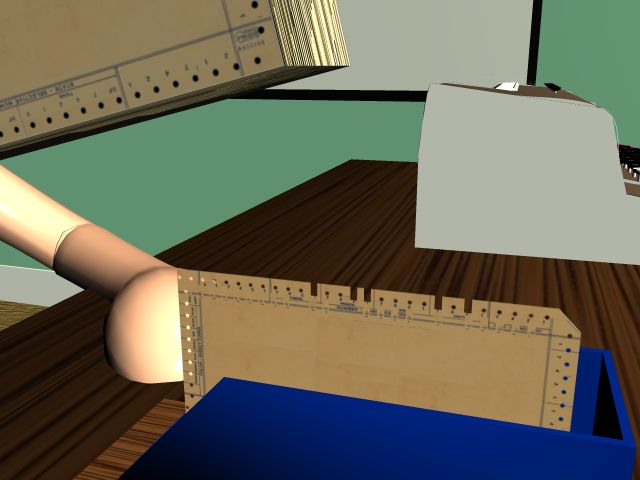 This may seem tiresomely slow, but the basic IBM sorter in that era also sorted one field at a time, with repeated sorts of the smaller remainders. The difference is that the IBM processed all digits in a numeric field at once. For cards with non-numerical fields, where each value in the field represented one value of a category (like M/F gender or Small/Medium/Large size) McBee and IBM would need the same number of passes.
McBee later made a more IBMish puncher and sorter, but no info is available online except this one picture:
This may seem tiresomely slow, but the basic IBM sorter in that era also sorted one field at a time, with repeated sorts of the smaller remainders. The difference is that the IBM processed all digits in a numeric field at once. For cards with non-numerical fields, where each value in the field represented one value of a category (like M/F gender or Small/Medium/Large size) McBee and IBM would need the same number of passes.
McBee later made a more IBMish puncher and sorter, but no info is available online except this one picture:
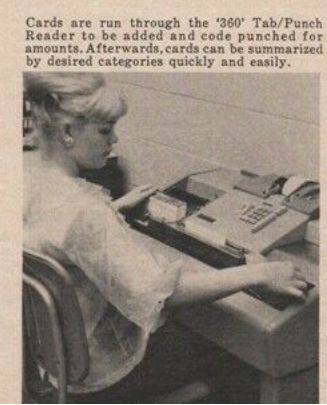 This machine didn't gain popularity for an obvious reason. When you OWN a niche, you need to claim and optimize the niche. Customers bought McBee BECAUSE it was naturally visual and lo-tech. McBee customers weren't buying McBee because they WISHED it was more like IBM.
Admittedly their marketers finally picked up the beehive theme!
This machine didn't gain popularity for an obvious reason. When you OWN a niche, you need to claim and optimize the niche. Customers bought McBee BECAUSE it was naturally visual and lo-tech. McBee customers weren't buying McBee because they WISHED it was more like IBM.
Admittedly their marketers finally picked up the beehive theme!
 McBee cards could be punched and sorted by machine. The punching side was partly mechanized, but the sorting side was usually done by hand.
This has advantages and disadvantages. The most obvious advantage is cost. For McBee you need to order some cards, and you need a ticket-punch and an icepick and some boxes. The cards are the only real cost. For IBM you need to order some cards, and you also need to rent a keypunch and a sorter for about $150 a month (equals $1000 a month today). Individuals and small businesses could afford McBee.
When modeling and animating these processes I'm on halfway familiar ground. In the '50s I often helped my father with mechanical grading and categorizing for his college lecture classes. It was a job I truly enjoyed. I did a lot of sorting, and a little bit of hand-punching, but never encountered the punching machine illustrated below.
A typical McBee card had punchable fields all around the edge, and a writable area in the middle. The open central area was another advantage over Hollerith, which was solidly filled with punchable numbers. You could type or handwrite a considerable amount of info or diagrams in the center.
McBee cards could be punched and sorted by machine. The punching side was partly mechanized, but the sorting side was usually done by hand.
This has advantages and disadvantages. The most obvious advantage is cost. For McBee you need to order some cards, and you need a ticket-punch and an icepick and some boxes. The cards are the only real cost. For IBM you need to order some cards, and you also need to rent a keypunch and a sorter for about $150 a month (equals $1000 a month today). Individuals and small businesses could afford McBee.
When modeling and animating these processes I'm on halfway familiar ground. In the '50s I often helped my father with mechanical grading and categorizing for his college lecture classes. It was a job I truly enjoyed. I did a lot of sorting, and a little bit of hand-punching, but never encountered the punching machine illustrated below.
A typical McBee card had punchable fields all around the edge, and a writable area in the middle. The open central area was another advantage over Hollerith, which was solidly filled with punchable numbers. You could type or handwrite a considerable amount of info or diagrams in the center.
 Cards were printed in a wide variety of individual styles for each business or purpose. Some had specialized non-numerical categories, some were all numerical, some were mixed alphanumeric.
McBee cards had a unique arithmetic system, based on 1 2 4 7. The system isn't a proper base-15, though it ranges from 0 to 14. The choice of these four digits was supposedly a compromise to minimize the number of punches needed. You could form all the digits from 0 to 9 with one or two punches. This was slightly more efficient than 4-bit binary.
Cards were printed in a wide variety of individual styles for each business or purpose. Some had specialized non-numerical categories, some were all numerical, some were mixed alphanumeric.
McBee cards had a unique arithmetic system, based on 1 2 4 7. The system isn't a proper base-15, though it ranges from 0 to 14. The choice of these four digits was supposedly a compromise to minimize the number of punches needed. You could form all the digits from 0 to 9 with one or two punches. This was slightly more efficient than 4-bit binary.
 Letters were formed with 1 2 4 7 plus an extra, called NZ for nonzero. This was NOT more efficient than a 5-bit binary system, but the familiarity probably made it faster. Binary digits were totally foreign to most people until the 1980s, and it's always better to amortize an existing skill.
[Here's a comparison of efficiency in terms of total punches needed.]
One definite advantage of hand-sorted cards is flexibility of form. When the stack is going to be handled carefully and personally, you can include samples of material or photo images on or in each card. McBee cards with inset X-ray images were useful in medical records:
Letters were formed with 1 2 4 7 plus an extra, called NZ for nonzero. This was NOT more efficient than a 5-bit binary system, but the familiarity probably made it faster. Binary digits were totally foreign to most people until the 1980s, and it's always better to amortize an existing skill.
[Here's a comparison of efficiency in terms of total punches needed.]
One definite advantage of hand-sorted cards is flexibility of form. When the stack is going to be handled carefully and personally, you can include samples of material or photo images on or in each card. McBee cards with inset X-ray images were useful in medical records:
 These inclusions couldn't pass through an IBM sorter or card-reader.
Hand punching was done with a special triangular hand punch that looked a lot like a ticket punch. My father didn't have the special, so we just used a ticket punch.
= = = = =
This punching machine was shown in one detailed description of McBee systems. No other information is available, so I'm semi-guessing the way it worked. I'm assuming that you would set up the patterns using the 8 columns of buttons for up to 8 numerical fields on one side of the card, then hit the big button on the right to punch these. The long side of a typical card contained 6 or 7 fields, so the 8 columns would usually handle one side of a card. I don't know what the 8 buttons on top were supposed to do. Maybe reset for each column? The process would have been like an adding machine except that you were consciously forming the 1247 pattern for each field.
These inclusions couldn't pass through an IBM sorter or card-reader.
Hand punching was done with a special triangular hand punch that looked a lot like a ticket punch. My father didn't have the special, so we just used a ticket punch.
= = = = =
This punching machine was shown in one detailed description of McBee systems. No other information is available, so I'm semi-guessing the way it worked. I'm assuming that you would set up the patterns using the 8 columns of buttons for up to 8 numerical fields on one side of the card, then hit the big button on the right to punch these. The long side of a typical card contained 6 or 7 fields, so the 8 columns would usually handle one side of a card. I don't know what the 8 buttons on top were supposed to do. Maybe reset for each column? The process would have been like an adding machine except that you were consciously forming the 1247 pattern for each field.
 Mr McBee has just punched in 1309, so the card would look like this after turning it over:
Mr McBee has just punched in 1309, so the card would look like this after turning it over:
 Now Polistra will demonstrate the first step of the selecting process. Assume she's looking for cards with 1309. She begins by finding cards with a 1 in the thousands place.
McBee selection is inverse to the usual way of thinking. It's more like the military volunteer method, where the soldiers who are NOT volunteering to check out the minefield are asked to step back, leaving the volunteers and the sleepers in the original row.
The poker was called a tumbler for some unknown reason. (It should have been a stinger.) Polistra inserts the tumbler into the 1 hole of the thousands field. Cards that were NOT punched in this slot can be pulled up, while the cards with a PUNCH in this digit stay down. She then places the UNWANTED cards in the red box, leaving only the few WANTED cards in the original blue box.
Now Polistra will demonstrate the first step of the selecting process. Assume she's looking for cards with 1309. She begins by finding cards with a 1 in the thousands place.
McBee selection is inverse to the usual way of thinking. It's more like the military volunteer method, where the soldiers who are NOT volunteering to check out the minefield are asked to step back, leaving the volunteers and the sleepers in the original row.
The poker was called a tumbler for some unknown reason. (It should have been a stinger.) Polistra inserts the tumbler into the 1 hole of the thousands field. Cards that were NOT punched in this slot can be pulled up, while the cards with a PUNCH in this digit stay down. She then places the UNWANTED cards in the red box, leaving only the few WANTED cards in the original blue box.
 She would then tumble a 1 and a 2 in the hundreds field, to complete the 3; then do nothing for the zero in the tens field; then tumble the 2 and 7 in the ones field.
All remaining cards in the original blue box would then be 1309.
She would then tumble a 1 and a 2 in the hundreds field, to complete the 3; then do nothing for the zero in the tens field; then tumble the 2 and 7 in the ones field.
All remaining cards in the original blue box would then be 1309.
 This may seem tiresomely slow, but the basic IBM sorter in that era also sorted one field at a time, with repeated sorts of the smaller remainders. The difference is that the IBM processed all digits in a numeric field at once. For cards with non-numerical fields, where each value in the field represented one value of a category (like M/F gender or Small/Medium/Large size) McBee and IBM would need the same number of passes.
McBee later made a more IBMish puncher and sorter, but no info is available online except this one picture:
This may seem tiresomely slow, but the basic IBM sorter in that era also sorted one field at a time, with repeated sorts of the smaller remainders. The difference is that the IBM processed all digits in a numeric field at once. For cards with non-numerical fields, where each value in the field represented one value of a category (like M/F gender or Small/Medium/Large size) McBee and IBM would need the same number of passes.
McBee later made a more IBMish puncher and sorter, but no info is available online except this one picture:
 This machine didn't gain popularity for an obvious reason. When you OWN a niche, you need to claim and optimize the niche. Customers bought McBee BECAUSE it was naturally visual and lo-tech. McBee customers weren't buying McBee because they WISHED it was more like IBM.
Admittedly their marketers finally picked up the beehive theme!
This machine didn't gain popularity for an obvious reason. When you OWN a niche, you need to claim and optimize the niche. Customers bought McBee BECAUSE it was naturally visual and lo-tech. McBee customers weren't buying McBee because they WISHED it was more like IBM.
Admittedly their marketers finally picked up the beehive theme!Labels: defensible times, Equipoise
